JADE
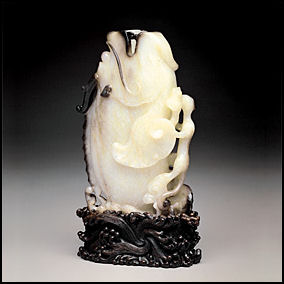
Ming-era jade fish
Jade comes in two forms: nephrite and jadeite, both of which are prized for their hardness, firmness and ability to be carved and the luster they generate that creates an appearance of transparency. Nephrite and jadeite are two chemically different and distinct materials. Both are technically rocks not gems, since they are mineral aggregates rather than crystals. Natural stones passed off as jade include chrysoprase, jasper, serpentine and soapstone. [Source: Fred Ward, National Geographic, September 1987; Timothy Green, Smithsonian magazine, 1984]
Jade is well known in East Asian, South Asian, and Southeast Asian art. Jade also has an important place in Latin America such as Mexico and Guatemala. According to the National Palace Museum, Taipei: “Jade possesses both the solid hardness of stone and the glistening moistness of water. It is as if the quintessence of all finest spirits, nurtured by the grandest mountains and most graceful rivers of all lands, has all bestowed upon and crystallized into jade, and jade alone. [Source: National Palace Museum, Taipei, npm.gov.tw]
“Jade, cool and hard to touch, yet gracefully beautiful and tenderly warm to look at, is the most constant element that withstands time and a culturally rich object that more than anything else holds the deep feeling and profound thinking of the people in Asia and Latin America. As far back as over seven thousand years ago, our forebears had learned from the toil of life such as digging and logging that "jade" was a stone of beauty and eternity.
See Separate Articles: JADE AND CHINA: OBJECTS, SOURCES, MINING, ARTISTRY AND SPIRITUALITY factsanddetails.com ; EARLY CHINESE JADE CIVILIZATIONS factsanddetails.com ; HISTORY AND DEVELOPMENT OF JADE IN CHINA factsanddetails.com
Websites and Sources: Chinatown Connection chinatownconnection.com ; International Colored Gem Association gemstone.org; Book: “Jade and You” by John Ng
Jade and Culture
Prized for both its beauty and symbolic value, jade has traditionally been worn as talisman by Chinese and shaped into a variety of objects. Jade was also prized by the Olmec and Mayan civilizations in America and by the Maori in New Zealand. The use of jade in Mesoamerica for symbolic and ideological ritual was highly influenced by its rarity and value among pre-Columbian Mesoamerican cultures, such as the Olmec, the Maya, and the various groups in the Valley of Mexico.
According to the National Palace Museum, Taipei: ““Based on archaeological data, it has been shown that over several millenia within the vast Pacific region, there appeared numerous cultures which venerated or worshipped jade. As the "jade" relics from these cultures were most often found to consist of nephrite or jadeite, minerologists have limited the scope of true jade to include only these two substances. [Source: National Palace Museum, Taipei, npm.gov.tw]
“From their long experience in making stone implements, people in ancient times developed an appreciation for the exceptional durability and luminous beauty of jade. They believed that this mineral was a sacred material that embodied an “essential” vital force. Jade was carved into ritual objects based on the cosmological views and religious faith of the time. The shapes, designs, and markings of these objects were believed to channel supernatural powers that could assist in the communication between the mortal and celestial worlds.”
Jade as a Mineral
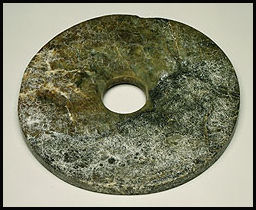 Nephrite is a silicate of calcium and magnesium. What distinguishes nephrite from other rocks with the same chemical composition is its needle-shaped grains and tightly interwoven, fluted, fibrous structure. Nephrite is stronger than most steels and has waxy, fibrous texture.
Nephrite is a silicate of calcium and magnesium. What distinguishes nephrite from other rocks with the same chemical composition is its needle-shaped grains and tightly interwoven, fluted, fibrous structure. Nephrite is stronger than most steels and has waxy, fibrous texture.
Jadeite is a silicate of sodium and aluminum. It is generally shinier and slightly heavier and harder than nephrite but not as tough. Jadeite rates 7 on Mohr scale of hardness compared to 6½ for nephrite and 10 for a diamond. About 90 percent of the worlds jadeite comes from Myanmar. There are additional small deposits of the stone in Russia, China, Japan, and North and Central America. The first shipments of the stone from Burma to China arrived in 1784, and has been greatly valued since then.
According to the National Palace Museum, Taipei: Chemically speaking a silicate of calcium and magnesium, nephrite belongs to the amphibole group of minerals. It occurs primarily in dolomitic marbles or in serpentinized ultramafics. Throughout the ages, nephrite has been frequently employed as a working material. [Source: National Palace Museum, Taipei, npm.gov.tw]
“Dark-green nephrite has its origins in the serpentinized ultramafics of Xinjiang Province's Tien Shan Ma Na Ssu. Similarly colored nephrite has been quarried in Hualien on Taiwan, New Zealand, Canada, and elsewhere. A silicate of sodium and aluminum, jadeite is classed as a pyroxene. Although in a class different from nephrite, jadeite shares many characteristics with it, namely a high degree of hardness and firmness, and a luster that lends an appearance of transparency.
Jade as a Gemstone
Jade has been used by some cultures to make jewelry and ornaments. Mostly of these are green varieties, though jade can also appears naturally in other colors. Yellow and white are particularly valuable. Nephrite is a silicate of calcium and magnesium in the amphibole group of minerals. Jadeite is a silicate of sodium and aluminium in the pyroxene group of minerals. [Source: Wikipedia +]
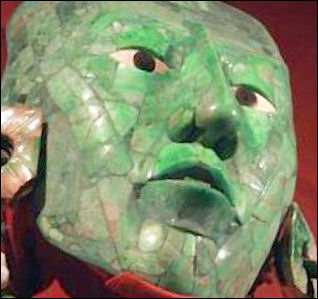
Mayan jade maskAccording to the National Palace Museum, Taipei: “The beauty of jade is a unique eight-thousand-year aesthetic experience. In the family of jade, either jadeite or nephrite exists in a variety of hues. Nephrite jade, aside from white, also comes in green-blue, gray, black, brown, yellow, green, etc. And the various colors of jadeite include pure white, emerald green, titian red, and mauve. The "cute use of tints" makes precisely the best of color variations and distribution in a given piece of jade the medium, adapting the shape and composition accordingly, so as to deliver an integrated visual message in the final work of art. [Source: National Palace Museum, Taipei, npm.gov.tw]
Jade may be enhanced (sometimes called "stabilized"). Some merchants will refer to these as grades, but degree of enhancement is different from colour and texture quality. In other words, Type A jadeite is not enhanced but can have poor colour and texture. There are three main methods of enhancement, sometimes referred to as the ABC Treatment System: Type A jadeite has not been treated in any way except surface waxing. Type B treatment involves exposing a promising but stained piece of jadeite to chemical bleaches and/or acids and impregnating it with a clear polymer resin. This results in a significant improvement of transparency and colour of the material. Currently, infrared spectroscopy is the most accurate test for the detection of polymer in jadeite. Type C jade has been artificially stained or dyed. The effects are somewhat uncontrollable and may result in a dull brown. In any case, translucency is usually lost. B+C jade is a combination of B and C: it has been both impregnated and artificially stained. Type D jade refers to a composite stone such as a doublet comprising a jade top with a plastic backing. +
Jade Simulates
The ancient Chinese did not make a fine distinction between true jade and jade simulates. Common jade simulates fall into four classes: 1) serpentine 2) feldspar, 3) carbonate and 4) quartz groups. Quartz group specimens, such as the transparent colorless rock crystal known to the ancient Chinese as "aquajade," are the most observed form of jade stimulant. Carnelian, known as "red jade" in antiquity, is ideal for carving.
According to the National Palace Museum, Taipei: “ Quartz group specimens are the most frequently observed jade simulants. Composed of silicon dioxide, quartz can be subdivided into the macrocrystalline and cryptocrystalline types, both of which can be further subdivided into numerous varieties. Among the varieties in the former class is the transparent, colorless rock crystal known to the ancients as "aquajade-" Also numbered among these varieties are citrine containing the ferric ion, rose guartz containing the titanium ion, and amethyst containing iron hydroxide. Occasionally, quartz may by found with needlelike inclusions. Lastly, upon exposure to radiation, transparent rock crystal is transformed into the darkly colored smoky crystal as a result of an alteration in atomic structure. [Source: National Palace Museum, Taipei, npm-gov-tw]
“Cryptocrystalline varieties, substances whose minute crystals are visible only under high magnification, and grouped under the name chalcedony and appear in numerous forms. Agate contains striae of assorted colors which form in the presence of coloring elements. Another class, carnelian, can be identified as the "red jade" of antiquity. When interspersed with white chalcedony, it forms a material ideally suited to carving techniques accommodating the natural coloration of a particular stone. In the displayed Carnelian brush washer decorated with bat and peach, the white area has been carved into the shape of a bat and fungus (Geoderma lucidum) which puns on and symbolizes the Chinese characters for good fortune and longevity. Chalcedony that lacks transparency is classified as jasper. On occasion it has been found in a form that displays a multi-layered effect and resembles a culinary delicacy, attributes that have endeared it to the Chinese.
“The dark blue areas in lapis lazuli are lazurite. Additional inclusions can be those of calcite and the gold-speckled pyrite. Nevertheless, the most noteworthy attribute of lapis lazuli is its soothing ultramarine color. Studies by scholars have shown that it was known in antiquity as ch'iu-lin.
Jade Colors
Nephrite comes in a variety of colors, including its most prized color yellowish-white "mutton fat," long cherished by Chinese carvers and collectors. Without impurities nephrite is snowy white. The presence of magnesium and iron produce a bluish white color. Yellow is produced by ferric ion, brown by hematite and grey and black by graphite.
Most jade has a bright green color associated with jade jewelry, though it comes in a host of other colors such as white, black, yellow, red, blue, and lavender — depending on the chemical composition of the stone. Variations of iron content in jadeite can produce brownish-red, dark green or lavender hues. White translucent jade is highly prized.
Green jadeite gets its green color from the element chromium. The most prized jadeite is translucent, emerald green jade known as "Imperial jade." Devious sellers can dye jade a richer color of green by heating it slowly to 212̊F and soaking it in chromium salts for two hours. The dye penetrates the cracks between the jade crystals and buyers are easily fooled. Good “dye jobs” are hard to detect. With bad ones the color seems to 'float' on the surface of the stone, indicating the dye has not penetrated deeply.
The Chinese character for jade, "fei-ts'ui, "represents two species of kingfisher with feathers whose colors are similar to those of brownish-red and emerald green jadeite. According to the National Palace Museum, Taipei: With jadite, “variations in iron content result in brownish-red, dark green, or lavender hues. Presence of minute amounts of chromium yields emerald green. Finally, the characters in the Chinese appellation for jadeite, fei-ts'ui, are those for two species of kingfisher whose feathers are of a color similar to that of brownish-red and emerald green jadeite. [Source: National Palace Museum, Taipei, npm.gov.tw]

Han-era jade suit
Sources of Jade
Up to 90 percent of the world’s jadeite — the most sought-after type of jade — is mined in the northern Myanmar town of Hpakant. Hundreds of tonnes are transported to state gem auctions in Yangoon. Myanmar, which have traditionally been held at least twice a year. Although jade artifacts have been created and prized by many Mesoamerican peoples, the Motagua River valley in Guatemala was previously thought to be the sole source of jadeite in the region. [Source: Agence France-Presse, September 15, 2013]
Dark-green Chinese nephrite usually comes from the serpentined ultramafics in Tien Shan Ma Na Su in the Xinjiang Province. Nephrite of this color is also quarried today in Hualien in Taiwan, in New Zealand and in Canada. The sources of ancient neolithic jades is unknown. Most of the nephrite jades from the Shang Dynasty (1766-1122 B.C) onward originated in dolomite deposits in the Kunlun Mountains in Xinjiang Province near western Tibet. Since most of this jade came from the Ho-t'ien (Hotan ) District, it was called "Ho-t'ien jade."
Nephrite is more abundant than jadeite and is found mostly in dolomitic marbles and serpentised ulramfics. It was first discovered by Chinese, who regarded it as very rare material and went through great trouble to obtain it. Today, it is found in many places, including China, Siberia, Taiwan, New Zealand, Alaska, California and Wyoming. Boulder-size deposits exist in British Columbia and Australia. The only expense is transported them. According to the Guinness Book of Records, the largest piece of jade is a piece of nephrite found in the Yukon Territory of Canada that weighed 636 tons.
Jade Business
The jade world is hard for outsiders to understand. Jade lacks clear, well-understood standards of quality as is the case with diamonds. A rating system exists that evaluates jade on scale from "A" for "exceptional" to "E" for "acceptable" based on tone, texture, translucence and color but it is not widely followed or recognized.
Many aspects of the traditionally jade business are like a guessing game. "Rough jade," wrote Timothy Green in Smithsonian magazine, "has an opaque skin, rather like the shell of a nut, caused by oxidation. To the untutored eye it looks just like any other large stone and the true contents is very hard to detect. That uncertainty is the very essence of the jade game...The logical approach would be to cut open the [rough jade boulder] immediately, but that would spoil the fun — and the potential for profit. The trick, for both buyer and seller, is to stake their judgement on three crucial points: How true is the color throughout the stone? How translucent is it? And are there cracks and flaws within?"
To determine the value of the jade a small "window" is cut into the skin of the boulder. Buyers use flashlights and spotlights to try and determine the depth and translucence of the color. One buyer told Smithsonian magazine, "Even the best appraiser can see only 70 percent of the value of the stones. He can see the quality of color but not quantity of the color.” Another buyer, with 21 years experience, said, “You need a good memory, because you must study every piece you buy and remember how the crust of the rough looked, and the color distribution when it was cut. Then, if you see a similar stone, you apply that knowledge. I often recall a stone I saw ten years ago."
In many places jade is still changed hands using an ancient Chinese ritual to keep the bidding price secret in which the buyer holds the jade he is bidding for in one hand and holds hands with the seller underneath a cloth with his other hand. The buyer only speaks the words for "hundred" or "thousand" and makes a signal with his hand under the cloth to express a number between one and ten. If a buyer extends two fingers under the cloth, for example, and shouts "thousand" he is making a bid for "2000."
Jade Carving
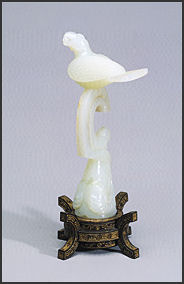
Qing-era jade bird
Up until about 70 years ago most carvers used the traditional method of drawing a bowstring back and forth to propel a drill with water and abrasive. Unlike ivory, jade is to hard to carve. It is shaped through cutting, grinding and polishing. Some craftsmen use electric tools, others use traditional tools such as pedal-operated treadle grinder, which has remained essentially unchanged for over a thousand years. One craftsman who prefers traditional tools told Smithsonian magazine, "We could use a diamond saw, but this traditional method gives him more control. There is less wastage, because you can cut a very thin slice."
Master jade craftsmen, like diamond cutters, take their time sizing up their pieces of jade. "It's an expensive material," one carver told Green, "and you've go to be careful, can't make mistakes. We think about it for a few weeks." One scholar told Green, "Ideally the shape you are looking at should be as close as possible to the original boulder. The craftsman is asking himself, 'How little can I do and still make it a pleasing piece?'" "Sometimes we just enjoy ourselves," a Chinese carver told Green. "But jade carving is very slow, and it takes a long time to sell, because the market for jade carving is narrow: just a few collectors here and in Japan and America.”
The workshops that mass produce simple jade jewelry are a different story. Green wrote: "A young craftsman in T-shirt and shorts uses a treadle cutter with a rope attached to a steel blade to saw through a five-pound piece of jade. His bare feet made a relentless patter on the treadle, and he regularly fed the blade with a mixture of abrasive grit and water."
The first step in making a bangle is carving an outline on the on the jade. Then the jade is cut into slices about half an inch thick and the holes are drilled out. "Drills like those of a dentist...punch out the center and shape the bangles," wrote Green, ", which are finally ground and polished on diamond wheels." The retail price for a jade bangle is usually about three times the wholesale price. Quality pieces have a fine grain, good color and translucency."
Burmese Jade, Hong Kong and China
Most of the world’s jadite is made into finished products in Hong Kong or Taiwan, mostly easy to replicate jewelry such as bangles and rings. Carving delicate figurines is time- consuming and expensive and there are only a few collectors that can afford the prices which often can be as high as $100,000 to $250,000. The highest price ever paid for jade jewelry was $9.39 million for necklace with 27 beads of emerald green jadeite. It was sold at a Christie's auction in Hong Kong.
The relation between the jade merchants of the Kachin State and the craftsman in the Yunnan Province endured for centuries but was broken by the Communist Revolution, when jade merchant set up shop in Hong Kong and carvers and crafts men migrated to Hong Kong from Beijing and Shanghai. Today, the quality of jade craftsmanship is much better in Hong Kong than it is in China or Taiwan.
Of the jadeite that reached China from Myanmar in the 1980s, about 40 percent of it was bought legitimately from auctions in Burma, 40 percent was smuggled through Thailand, and the remainder came directly from Burma to China's Yunnan province.
These days Chinese in Yunnan are buying more and more jade directly from the Kachin State. Much of the jade is purchased by buyers from China's National Arts and Crafts Import and Export Corporation in Beijing and the Guangdong Arts and Crafts Company in Guangzhou (Canton).
High Prices, Bubble and Shortage Worries in the 2010s Jade Market
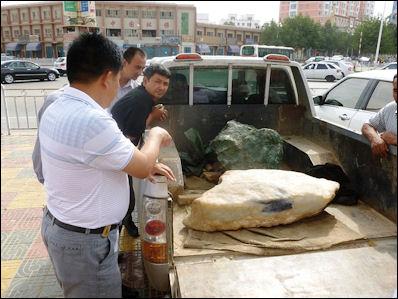
jade in back of a truck in KhotanThe jade market in the early 2010s was hit by high prices, rumors about shortages in Myanmar and bubble worries. AFP reported: “With no international pricing system, values have been increasing since 2005 as the newly-rich in China have bought up jade products. Seen as a classier option than gold, it has become a status symbol. Dealers are now worried that quality raw jade from Myanmar is dwindling as the country plans to process and sell its own jade products. [Source: Agence France-Presse, September 15, 2013]
“Myanmar keeps its cards close to its chest in a famously murky trade, and rumors are rife among dealers about its plans as the country opens up economically. Jade dealer Liang Jianhui, based in southern China’s Guangdong province and one of 7,000 buyers at the gem auction in Myanmar’s capital Naypyidaw in June, told AFP that he could no longer afford to buy high-quality jade. One bidder told AFP the auction had been less busy in the past two years than previously, with high prices putting dealers off. “I set aside more than two million euros for the auction, only to find that I am too poor to win a bid for one single piece of top-end jade,” said Liang. “If a piece of raw jade sold for 100,000 euros in the past, people would make an offer of 500,000 euros for the same one this year. One dealer said Chinese buyers had backed out of collecting their jade after having second thoughts about the high prices, while another said Chinese bidders had gone in high purposely to put the raw jade out of reach of their rivals.
Up to 90 percent of the world’s jadeite – the most sought-after type of jade – is mined in the northern Myanmar town of Hpakant and hundreds of tonnes are transported to state gem auctions, which have until now been held at least twice a year. But in 2013 there was only one major auction, which saw the number of jade lots down by 38 percent compared with the previous auction in March 2012, according to local media quoting official figures, although it was still reported to have reaped $2.4 billion in sales. “What they want now is not only to export raw materials, but also to process jade domestically and sell it to China,” said Li Lianju, a deputy director of Yunnan Land and Resource Department, who oversees the jade trade between Myanmar and China’s Yunnan province, a major commercial hub for the gemstone. “The value of raw jade rises more than twentyfold after being carved and turned into rings, bangles or necklaces,” said Zu Engdong, head of Gemology at Kunming University of Science and Technology in Yunnan. “So it makes full sense for the Myanmarese to process jade themselves.”
“Some fear Myanmar will close the jade mines altogether or slow down production to protect jade sources. Fighting in Kachin state may also have affected jade mining. What is certain is that prices for those buying raw high-grade jade are astronomical, trickling down to merchants who are upping prices to maintain their profit margin. Yunnan’s Li says prices of lower-grade jade are already dipping. “The bubble of low to middle end jade has burst first given the little fear of raw material shortage,” he said. While prices of high-end jade are likely to jump after the raw material from the June auction is processed, Li predicts such surges cannot continue in the face of lack of trade. “By the end of the year, the prices will start to drop from the sky,” Li said.
Hong Kong Jade Market Hurt by High Prices and Bubble Worries
Hong Kong is one the main market places for both high-quality jade art works and mass-produced tourist pieces. In the early 2010s, it was hit by high prices and worries about a bubble burst. AFP reported: “Jade is a status symbol of the super rich in Asia, but rocketing prices in the top-end of the market have left traders in Hong Kong struggling to find buyers. With the cost of high-quality raw jade and jade products surging repeatedly in the past eight years, prices tags are now becoming prohibitive and experts predict the bubble must soon burst as buyers are stepping back. Driven up by the appetite of wealthy Chinese, the rising cost of jade is also being fuelled by fears of a shortage in supply from Myanmar, the key source. “Consumers cannot accept the current high prices, therefore, no deal is reached,” Hong Kong jade dealer Li Kwong-kei told AFP at the Hong Kong Jewellery and Gem Fair.[Source: Agence France-Presse, September 15, 2013]
“Li, who has participated in the fair for more than 10 years, said it was quieter than in 2011 and 2012. “We are forced to raise prices — it is increasingly hard to get high-quality raw jade from Myanmar. If you do not pay more, the good raw materials will be owned by the others,” Li added, holding a green jadeite bangle with a price of HK$2 million (US$260,000). “I have decided to wait for the prices of high- and mid-end jade to drop,” said Judy Chen, a Taiwanese buyer at the fair. “It appears to me that their prices are kind of at the peak.”
“Small businesses have also been affected — stallholders at Hong Kong’s famous outdoor jade market while away hours chatting with their neighbors, as customers remain sparse. “I have seen some of my peers quit their businesses,” said 54-year-old stall owner Wong Fung-ying. “The prices are high while the market is quiet.”
Image Sources: Mostly from the the Palace Museum in Taipei with some from the Silk Road Foundation, Wikimedia Commons, National Museum in Beijing amd the Metropolitan Museum of Art , Beifan, CNTO and BBC
Text Sources: Palace Museum, Taipei, New York Times, Washington Post, Los Angeles Times, Times of London, National Geographic, The New Yorker, Time, Newsweek, Reuters, AP, Lonely Planet Guides, Compton’s Encyclopedia and various books and other publications.
Last updated November 2021
